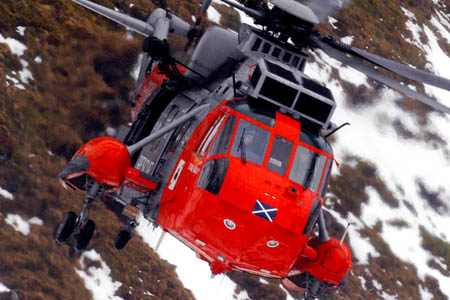The crew of a Royal Navy helicopter has described a difficult rescue in freezing conditions on England’s third highest mountain.
The search and rescue Sea King was called in from HMS Gannet in Ayrshire to help a climber who fell on Saturday afternoon while climbing on Helvellyn’s headwall above Red Tarn.
The 20-year-old student from London was with a group of fellow students on the 950m (3,117ft) mountain when she slipped and suffered multiple injuries, including a suspected broken thigh bone and injuries to her face.
A spokesperson for the Royal Navy said: “The alarm was raised at around 4pm and police alerted Patterdale Mountain Rescue Team and assistance was then also requested from HMS Gannet at around 4.30pm.
“Lifting from its Ayrshire base, the helicopter sped to the Lake District and was on site within 40 minutes, just ahead of the first of the MRT members.
“Immediately it became clear that all was not straightforward. There were a surprisingly large number of climbers on the mountainside, all equipped with torches, whose natural reaction on hearing a helicopter was to look up at the aircraft. However the mountain rescue team was able to talk the helicopter in to the location of the correct group.
“In the hover, the crew was 2,000ft up, in –11C and pitch darkness on a moonless night.”
Winchman Petty Officer Marcus ‘Wiggy’ Wigfull, a qualified paramedic, continued: “We arrived on scene to find that there were probably about eight or 10 different totally unrelated groups of climbers on the mountainside in that area, many wearing headtorches. And with the arrival of the helicopter they all looked up, which made it difficult to find our casualty.
“Fortunately MRT members were able to narrow the area down for us and we used the aircraft’s spotlight to find the injured woman and her party.
“The crew took the helicopter into a hover just below the casualty and I was lowered some 130ft to the 45 degree slope below. I stayed on the wire, as it was too dangerous to detach and walked up the icy slope.
“There was a small group around the casualty and a member of the MRT arrived just as I was put down.
“After assessing her condition, I was able to give her a gas and air pain relief combination and I, along with other members of the group, managed to manoeuvre her onto a stretcher, cutting away her rucksack once she was firmly in place and completely secured.
“At that point we were able to bring the helicopter in lower to make the winch as quick as possible, but always bearing in mind the downwash from the rotors and trying to keep that as minimal as possible – not only is it quite strong, but it was kicking up quite a swirling snowstorm, which made things trickier. So we winched about 80ft up to the helicopter – the downwash wind chill must have taken the ambient temperature down to around about –30C.
“In a situation like this one, you’ve got to think quickly on your feet, not just about the casualty, but the safety of the rest of the group and the aircraft in adverse conditions. It can be hard enough to treat a casualty on flat ground in daylight on a sunny day, but throw in the slope, weather and darkness and it all becomes quite a different matter. The MRT guy who was with me really helped, as he was able to keep the other people at the scene safe while I looked at her injuries.
“I’m just glad it all turned out as well as could be hoped for and that we got her off the hill safely.”
The climber was then flown to West Cumberland Hospital, Whitehaven for further treatment.
The Sea King was piloted by Lieutenant Commander Geoff Richardson and Lieutenant Will Murray. Lieutenant Commander Dave Reese was the observer.
The HMS Gannet crews, based at Prestwick Airport, are the busiest in Britain, carrying out 447 missions last year, with 378 people rescued.

beryl brakes
03 December 2010well done all pf you glad you are back safe and sound
Steve
04 December 2010we are all very lucky to have you guy's around - a truly awesome effort by all